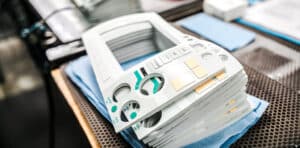Emergency rescue operations can be volatile for military personnel. Whether it’s a Coast Guard cutter assisting a ship that’s taking on water or soldiers securing an unsafe area, the reliability of their equipment is crucial. The use of communications devices to coordinate efforts plays a vital role in the success of many different types of missions. In order for military personnel to communicate effectively, military keypads must adhere to some basic principles in their designs.
Watertight Keypads
Damp conditions created by inclement weather or simply being surrounded by salty air for several hours at a time can wreak havoc on regular communications devices. For example, a standard keypad can capture condensation on its buttons, dumping water droplets into the inner workings of the keyboard. Military silicone rubber molding can be designed to prevent keyboard penetration. Even if condensation develops on a device made with custom silicone molding, the material is water resistant. The liquid can be poured off or wiped down with a cloth or paper towel, depending on how much accumulates. Unlike some plastic materials, the silicone rubber molding won’t scratch.
Reliability
When a military communications device is used to coordinate operations for land, sea and air missions, the keys need to function correctly every time. When a specific button is pressed, it had better provide the right response. From inputting alpha-numeric code sequences to holding down a signal alerting personnel that a rescue basket has been launched, reliability is crucial. It’s important for the device designer to choose a quality material that can withstand the repetition, such as silicone rubber. It’s also important to have a military keypad manufacturing company capable of making durable and reliable keypads. Some manufacturers use inferior processes, such as compression molding, or cheap materials which fail after several repetitions of punching keys. When designing military communications devices, choosing liquid silicone injection molding in specific part configurations can improve the chances that the keys will do what they are supposed to do.
Actuation Forces
How hard someone has to push a button to make it work, often referred to as the actuation force, is another important part of designing military keypads. The button must provide enough of a response so that the user is confident that the keys are working. They also must be soft enough to avoid tiring out fingers or missing strokes due to lack of force for contact.
Execution
When designing keyboards for communications devices, it may be helpful to consult the military keypad manufacturing company that will be making the silicone rubber components. The company’s engineers can specify any necessary features or requirements needed to make the product usable under the circumstances. For example, there may be ways to improve the device through sealing and coating capabilities.
To learn more about how SiTECH Corp. can transform your military keypad design into a functional keypad for a communications device, read through our Application Guide.







